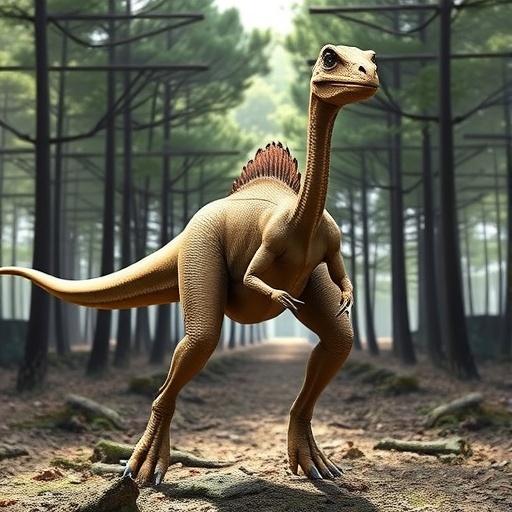Sixty-six million years ago, the ancient landscapes of South America were home to a unique group of sauropod dinosaurs distinguished by their remarkable ability to rise onto their hind legs for extended durations. Unlike many of their colossal contemporaries, these long-necked, quadrupedal giants displayed a bipedal posture that offered evolutionary advantages, from reaching inaccessible foliage high in prehistoric trees to defending themselves against predators. This breakthrough insight into their biomechanics emerges from a recent collaborative study that harnessed cutting-edge computational techniques to reconstruct and analyze the stress endured by their femurs under bipedal stance.
The focus of this pioneering research was on two genera of South American sauropods: the Brazilian Uberabatitan and the Argentine Neuquensaurus. These dinosaurs, approximately the size of modern-day elephants, stood apart from the typical enormous sauropods by their relatively smaller stature—though an adult Uberabatitan could still grow up to an impressive 26 meters in length, making it the largest dinosaur ever discovered in Brazil. This paradox of their size and locomotion capabilities became the central question: Could these titans truly maintain an upright, bipedal posture, and if so, under what conditions?
Researchers led by Julian Silva Júnior, a postdoctoral scholar in engineering biomechanics at São Paulo State University, approached this question by digitally reconstructing the femur bones of seven sauropod specimens from various evolutionary lineages and sizes. These digital models were based on fossilized bones housed in prominent natural history museums worldwide. By applying a rigorous engineering tool called finite element analysis (FEA), the team simulated forces acting on the femurs—both external forces such as gravity and internal forces exerted by musculature—to estimate the mechanical stress during bipedal standing.
Finite element analysis, a methodology widely employed in engineering fields for designing resilient bridges and airplanes, breaks complex structures into smaller elements that can be individually analyzed. Through this computational framework, the researchers virtually subjected the dinosaur femurs to the weight and postural demands that standing on two legs would require. Two distinct scenarios were modeled: an extrinsic case focusing on gravitational forces, and an intrinsic case examining muscle forces acting on the femur. The combined data illuminated the biomechanical feasibility of sustained bipedal posture in these prehistoric giants.
The outcomes were revelatory. Among the specimens analyzed, the juvenile Uberabatitan ribeiroi and Neuquensaurus australis—the two South American genera examined—exhibited femoral structures that endured notably less stress compared to their more massive counterparts. These dinosaurs had developed more robust femurs capable of better dissipating the mechanical loads arising from their body weight during bipedal standing. This contrasted with larger sauropods, which, despite possessing enormous muscles and femurs, appeared less adapted to prolonged upright stances due to excessive femoral stress.
This biomechanical insight lends compelling support to the hypothesis that younger, smaller individuals within these species were the primary practitioners of bipedal behavior. Adult Uberabatitans, by contrast, may have found such postures uncomfortable or challenging to maintain, restricting their bipedal activity to shorter bouts or specific functional contexts. This allometric constraint highlights how growth and ontogeny influenced locomotive abilities in these dinosaurs, demonstrating a nuanced evolutionary interplay between size, skeletal strength, and behavior.
Beyond pure biomechanics, the study suggests multiple ecological and reproductive advantages conferred by this bipedality. Raising themselves on hind legs would have granted these sauropods access to foliage and leaves situated at extreme heights—resources unavailable to purely quadrupedal herbivores. Furthermore, adopting an upright posture could have served as a defensive display, magnifying their intimidating presence to deter predators. Mating rituals may also have benefited, allowing males to mount and signal dominance or attractiveness through postural exhibition, although these behavioral aspects warrant further fossil and biomechanical correlation.
However, the researchers caution that their models did not incorporate all biological factors present in living organisms. For instance, cartilage, which cushions and distributes load across joints, was not included in the simulations due to its absence in the available fossil specimens. The role of the tail, potentially used as a prop in a tripodal stance for enhanced stability, was also not directly modeled. These omissions suggest that the actual biomechanical stresses experienced by these dinosaurs could have been mitigated somewhat by soft tissue dynamics, making sustained bipedality even more plausible.
Nevertheless, the strength of the study lies in its comparative approach. By examining diverse sauropod lineages and consistently applying the computational analysis, the authors provide a robust framework to infer behavioral and anatomical evolution millions of years ago. This method reveals how evolutionary pressures shaped bone robustness and locomotive strategies differently across species and growth stages and underscores the importance of biomechanical modeling in paleobiological research.
This research was supported by the São Paulo Research Foundation (FAPESP) and conducted through an international collaboration among Brazilian, German, and Argentine institutions. It exemplifies the integration of paleontology with advanced engineering techniques to push the boundaries of what we know about extinct megafauna. Such interdisciplinary approaches are vital for reconstructing the life histories of creatures that vanished long before humans walked the Earth.
Ultimately, the ability of these sauropods to rise on their hind legs redefines our understanding of dinosaur ecology during the Late Cretaceous period. It challenges the traditional view of sauropods as exclusively quadrupedal behemoths and opens new avenues for exploring their behavioral repertoire, feeding ecology, and evolutionary adaptations. This study not only enriches the fossil narrative but also demonstrates how modern technology breathes new life into ancient bones, transforming static remnants into dynamic stories of survival and innovation.
Subject of Research:
Biomechanics and postural analysis of sauropod dinosaurs through computational modeling.
Article Title:
Standing giants: a digital biomechanical model for bipedal postures in sauropod dinosaurs
News Publication Date:
August 1, 2025
Web References:
- Fundação de Amparo à Pesquisa do Estado de São Paulo (FAPESP): www.fapesp.br/en
- FAPESP News Agency: www.agencia.fapesp.br/en
References:
- Published article in the journal Palaeontology, DOI: 10.1111/pala.70019
Image Credits:
Guilherme Gehr




